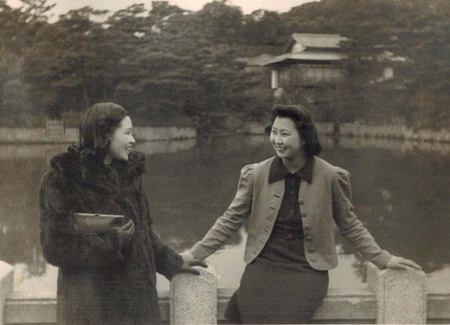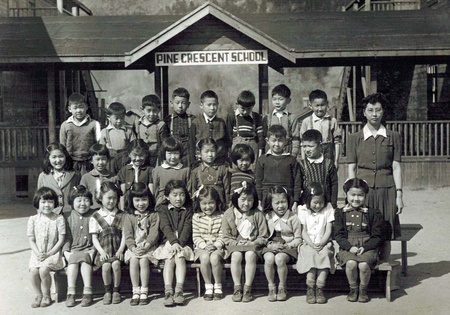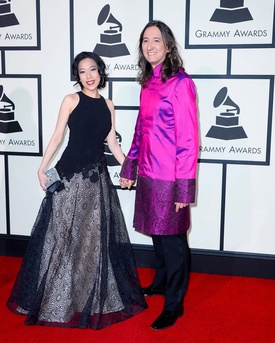There’s a glint of pure excitement in the eyes of Grammy-nominated flutist and composer Ron Korb as he begins to open up about his experiences in Japan. “Every single day, there was some new thing, some exciting little thing,” he reminisces, “It was never boring. I just loved every minute of it.” From the good, to the bad, and to the beautiful, Korb recalls the events that have made the country worth visiting 21 times.
Korb’s journey to Japan began with his mother Mariko “Mary” Ennyu, who was born into a Japanese immigrant family in 1920. While she was raised in Canada’s remote Buckley Bay in Haida Gwaii and Vancouver, Mary moved to Kobe, Japan to join her sister in 1939.
Her stay was rather short-lived, however. Wartime tensions were boiling over and, after a year in Japan, Mary made the move back to Canada. Evacuation notices were eventually dispensed to Japanese-Canadians across the nation and Mary found herself working as a teacher in an internment camp in the Slocan Valley—a position that she was severely under-qualified for.
“Honestly, she didn’t feel she had proper education herself,” Korb says, “Her schooling was very erratic in Buckley Bay, they didn’t have a steady teacher. She didn’t feel qualified to teach but that’s the way it worked! They just had to create their own society from nothing.”
Mary eventually learned to make do, and despite the modest resources, a number of the pupils at the Pine Crescent School became important figures—such as environmentalist David Suzuki, artist Aiko Suzuki, novelist Joy Kogawa, and architect Raymond Moriyama. After her release from camp, Mary moved around various parts of Canada and later married Korb’s father, Lothar.
But Mary’s love for Japan had never truly died out and was ultimately passed on to her son. Looking back to his school days, Korb recalls classroom assignments and projects revolving around anything and everything in Japan. From the city of Nara to the shakuhachi flute, he claims that his early-onset fascination with his mother’s heritage always outweighed any fledgling interests in his European roots.
“It never really interested me. I was always more interested in Japanese culture,” he claims.
The country’s captivating charm and familial calling eventually lured him into finally purchasing a plane ticket with his mother in 1988—almost 50 years after her move to Kobe. Korb also further researched his Japanese heritage and arranged a visit to meet some living relatives during his time in Kyushu.
As he rhapsodizes over both the grandeur and charm of Japan—including ancestral sites, kabuki, and ramen shops—it becomes evident that Korb’s childhood enchantment flourished well past his adolescence. From the lights of Tokyo to the serenity of his grandparents’ hometowns, Japan was nothing short of life-changing.
The trip was so monumental, in fact, that Korb’s musical endeavors began to take on a new face—one with Asia written all over it.
While Korb admits that he wasn’t born into a musical family, a local jazz flute player on TV and Grade 6 recorder lessons gradually immersed him into the world of flute playing. His enthusiasm for the flute carried over to the university level, where he studied at York University and, later, the Faculty of Music at the University of Toronto.
But there were times when Korb’s fervor for the flute wasn’t quite so ablaze.
“I was sort of getting a bit tired of it, and I didn’t really know why,” he recalls pensively, “I did some masterclasses in Europe that summer after I graduated, and I was just somehow sort of losing the love of it… the love of the flute.”
Yet, as evident by Korb’s more than thirty released albums and extensive touring route, his affection for flute playing did not come to an irreversible standstill. With a gentle push from his colleague Donald Quan to play on their 1990 Tear of the Sun album and a curious encounter with a bamboo flute maker, Korb was able to rekindle his passion—a feat that would later culminate in an overwhelming fascination with the purities of both the Japanese flute and Asian music as a whole.
Like his mother before him, Korb made the move to Japan two years after his initial 1988 trip and sought out traditional shinobue, nohkan, and ryuteki player Michiko Akao as his mentor. After demonstrating his more than competent flute playing abilities to her, Akao accepted him as her student, despite his relatively short stay in Tokyo.
Captivated by the unique sound and rawness of Japanese instruments, Korb began to examine the broader nature of the Asian musical aesthetic at a closer level. Soon, the concepts of “Beautiful Sadness” and “Absolute Beauty,” became particularly shining, overarching themes in his compositions. From his 1993 breakout album Japanese Mysteries with Hiroki Sakaguchi to his 2015 Grammy-nominated Asia Beauty, Korb lays out the allure of East Asian music simply:
“It has timeless elements from the ancient past that can be felt so powerfully in the here and now.”
Korb also became well-versed in a variety of instruments outside of Japanese flutes, a venture that has allowed him to interact with a worldwide collection of interesting individuals. Wielding a command over a global range of instruments, Korb says that his duality in Western and East Asian instrumentation has made him a notably attractive find for film composers; namely, his work on the blockbuster Chinese historical film The Eight Hundred—Ba Bai in its original language—made for a remarkable showcase of his versatility in the world of woodwinds. At this point, Korb has played flute on more than 100 movies and TV series, 300 albums, and over 600 songs for other artists.
Today, the flutist is back home in Canada after completing a cross-Asia tour shortly before lock-down orders were put in place. Korb remains active on the music scene as he composes from home and mentions that work on a new album is well underway. But the COVID-19 pandemic has had some significant effects on both his career and the musical order of business, with touring being completely eliminated from Korb’s agenda and recording moved to a home studio.
Nevertheless, Korb says that recognizing the shifting tides in how music is consumed is vital for all musicians in this day and age. More specifically, he mentions building an online presence as digital platforms and social media increasingly become lifelines for musicians in the recent decade.
“Now, I’m more focused into the new technologies and—now that streaming is really here to stay—how to use streaming. I even received a government research grant,” he explains, “And it was just about developing methods to help Canadians how to improve their discoverability online.”
After travel restrictions are lifted, though, Korb remains hopeful for another trip to the “Land of the Rising Sun” and encourages others to explore the country as he has—whether it is their 1st or 22nd time.
“Just get over there,” Korb enunciates in his final remarks, “It will enrich your life in ways you would have never dreamed.”
© 2021 Kyra Karatsu
















